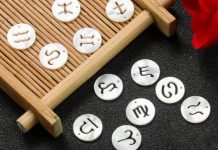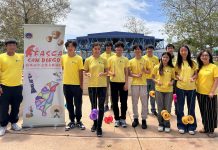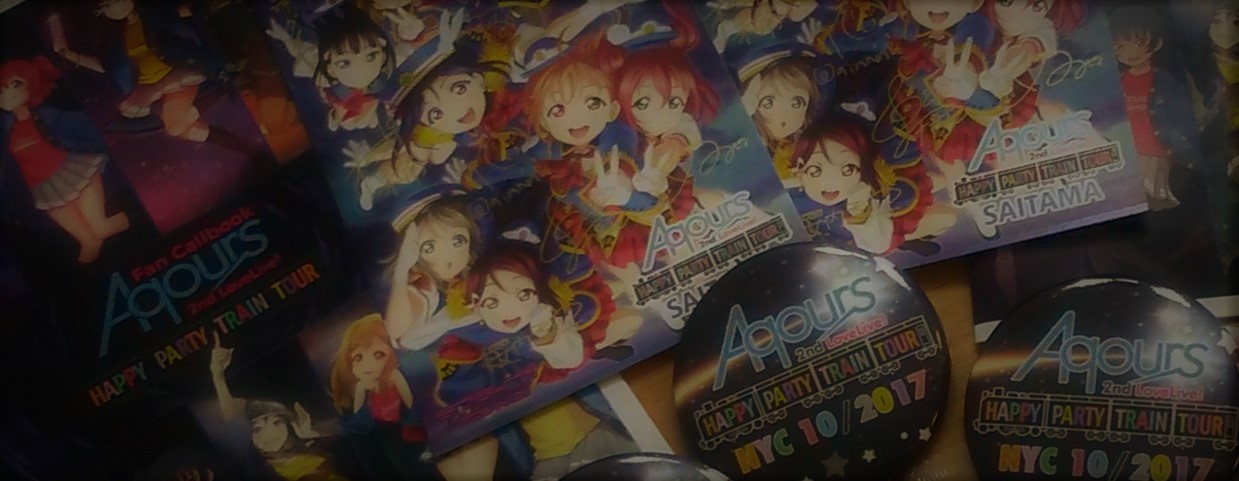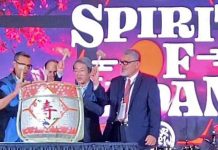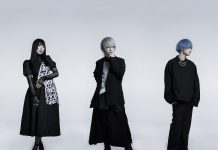Welcome to the world of Love Live!, a multimedia project based on animated schoolgirls becoming school idols. But there is more to Love Live! than a 2D anime show. Love Live! school idols are portrayed by a cast of professional seiyuu (“voice actors”), not high schoolers, who voice the anime, release CD recordings, and perform live concerts. During live concerts, the seiyuu match their animated counterparts’ music videos. At other times, non-animated songs drive focus directly onto the seiyuu. This simultaneity blends the seiyuu and their characters into one entity, creating 2.5D existence whereby 2D anime and manga characters “become” 3D via their actors and actresses. Factors preventing Love Live! animated idols from being completely 3D include the characters’ fictional origins and the 0.5 of their actresses’ individualism.

These increasingly popular 2.5D live shows are made available outside Japan to its niche audiences through live streams, delayed viewings, and imported Blu-Rays and DVDs. A delayed screening of Aqours, the current nine-member Love Live! group, brought full houses to New York’s Village East Cinema. Tickets for the Saturday and Sunday shows sold out in time, and the cinema added a third showtime considering this.

Like many, my sister and I were acquainted with Love Live! via various multimedia platforms: the rhythm game app, the anime, and trading card games. Being in New York, I took the chance to experience a different form of entertainment. Attending an actual live show in Japan would require both travel and ticket costs. The tickets are acquired either through buying Blu-Rays for serial codes and entering lottery rounds for better seats or waiting out for general, blocked-seat, and secondhand sales. So, I decided to check out a J-pop concert screening of Aqours’s second tour, “HAPPY PARTY TRAIN,” held in New York.
Pre-show

I prepped for the show like I would for an anime convention. I bought correlating cosplay of Aqours’s uniforms from their fictional Uranohoshi Girls’ High School. Then, I decorated my itabag with character merchandise since fans often sport itabags as portable clear-view museums of their favorite anime characters. To top it off, I packed light sticks, an essential concert accessory for Asian pop concerts.
October 15, 2017 was a cool and cloudy day. A waiting line started to form well before the 11:00 a.m. show. Fans kept themselves busy trading and selling items, passing out fan-made programs and call guides, playing the app game, and chatting about their favorite Aqours members. There was even a fan who recreated the “scouting” element of the app game, distributing random envelopes featuring printed cards of Aqours characters. The variety and quality of cosplay was impressive. Many fans cosplayed in themed costumes, including “HAPPY PARTY TRAIN” outfits, You’s cat-eared Halloween costume, and winter Uranohoshi High uniforms.


Showtime
The event took place at Village East Cinema, a small historic Yiddish theatre that now features foreign films and animated features. My sister and I entered about half an hour before the show with ample time to find first-come-first-serve seating or purchase official concert goods sold at Japan shows. I found plush balcony seating in the main auditorium with a generally unobstructed view of the giant screen. A couple announcements later, the four-hour screening began.
The screening featured raw footage from Aqours’s Day 2 at the 34,000-capacity Saitama MetLife Dome. Aqours opened the concert with the tour’s titular song “HAPPY PARTY TRAIN” before the seiyuu cast went through their individual introductions, calls, and responses. The entire program consisted of 28 different numbers, including 7 un-subtitled MCs, and 3 encores. Performances of Aqours’s newly released summer songs premiered at the Saitama concert, interspersed with some Aqours classics such as “Mijuku DREAMER,” “Koi ni Naritai AQUARIUM,” and “Mirai Ticket.” Two-thirds into the show, Aqours broke into three-member subunits before regrouping for the final stretch through the encore.
But it wouldn’t be a Japanese idol concert without fan chants and interactivity! Despite being a delayed viewing of the concert, the venue was wild with energy. Fans resounded with wotagei—cheers, claps, and singing specific to each song in the setlist. Concert cheerleading is an important Japanese idol concert custom. Wotagei customs allow fans to participate in an orderly manner by yelling “hai,” “fu,” “fuwa,” or a combination chant during intros, pre-choruses, and choruses. Without losing the fun, it also demonstrates respect to the performers and prevents them from being drowned out by consistent cheering. Not sure what to do? It’s ok! There were wotagei section leaders who newcomers can clearly follow. Call books provided before the show also outline calls for the songs.

Colored light stick practices are also important. Each Aqours member has her own representative image color and color-coded costumes. In general practice, fans would switch the light stick to their favorite member’s color except for when a song has its own standard color. For example, “Koi ni Naritai AQUARIUM” uses You’s light blue and Chika’s orange while “HAPPY PARTY TRAIN” features Kanan’s light green. For subunit songs, fans pick the color of their bias in that respective subgroup to show respect to the subunit performers currently on stage. It took a bit of practice with my 12-color-switching light stick, but therein lies the fun of it all!
Impressions
My three favorites from the concert include the EDM “Daydream Warrior” and the rocking “Thrilling One Way.” Performed back to back, the catchy music and performance staging leaned towards a cooler feel, especially with the dance break and excellent camerawork in “Daydream Warrior.” But my top favorite was the “Sunshine Pikkapika Ondo.” Perhaps it is my penchant for folk music, but the ondo was a great first encore honoring Japan’s Bon festival tradition. The stage transformed into a tall bandstand (yagura) with Chika (CV: Anju Inami) performing a taiko sequence for the first half of the song while the other eight members, fashioned with Happi coats and hand fans, danced their bon dance. All nine seiyuu were involved and strong in their roles and interactions with the audience, especially when You (CV: Shuka Saitō) and Yoshiko (CV: Aika Kobaiyashi) were fun and energetic with the happy virus—always smiling and naturally humorous on stage. I also appreciated how the seiyuu acknowledged the screening attendees in their MCs and covered their fanbases not in physical attendance at the Saitama live.
All in all, I would say that my first concert screening experience was not only fun but also culturally informative. There is a learning experience in everything, and school idols are another facet of modern Japanese culture. School idol culture targets a niche audience, and its appreciation is not based on exceptional vocals or advanced choreographies. Rather, school idols play on the values of enthusiasm, dreams, hard work, and achievement—added cuteness is a bonus—to put a smile on fans’ faces. They are a Japanese phenomenon that attracts fanbases including aspiring school idols, teenage fans, and otaku. Love Live! has successfully integrated this idol culture across countless media and musical platforms, merchandise, and live shows. It is lucrative business considering how Love Live! asserts its presence in the current anime setting and garners a diverse fanbase.
The video screening is a good introduction to Love Live! live concerts with the benefit of seeing the performances up close and not having to stand amidst thousands of fans. I do recommend concert viewings to Love Live! fans as a chance to see live renditions of animated and non-animated songs. For newcomers to the franchise, screenings are an entryway to learning about seiyuu, anime school idols, and 2.5D entertainment.

After the show, Village East Cinema gave out collectable signed postcards to every attendee. My sister and I walked away from the happy partying train (pun intended) towards Kinokuniya New York to shop for some Love Live! goods, where I ran into a few fans from the screening. Our concert outing ended with some delicious Japanese bento at Sunrise Mart in Midtown.

About Love Live! and Aqours
Love Live! is a multimedia project that produces fictional high school idols backed by professional seiyuu talent. It was created by three Japanese multimedia companies: Lantis, Sunrise Inc., and Dengeki G’s Magazine (ASCII Media Works). The project’s outreach includes not only print, digital, and audio media platforms but also live shows and activities hosted by the seiyuu. The series develops via fanbase participation, allowing fans to vote for the group’s name, subunits, popularity polls, stage costumes, and so forth.
Aqours is a nine-member group launched in 2015 featuring characters from the Love Live! Sunshine!! multimedia project. They are based in Uchiura, Numazu, Shizuoka Prefecture, Japan. Aqours’s fictional Uranohoshi all Girls High School is based on the actual Nagaisaki Junior High School. Aqours and Love Live! Sunshine!! followed the success of its predecessor, μ’s (pronounced “Muse”), from the original Love Live! School Idol Project that began in 2010. A correlating anime is currently running its second season on Crunchyroll.
Cast: Chika Takami (CV: Anju Inami), Riko Sakurauchi (CV: Rikako Aida), You Watanabe (CV: Shuka Saitō), Yoshiko Tsushima (CV: Aika Kobayashi), Hanamaru Kunikida (CV: Kanako Takatsuki), Ruby Kurosawa (CV: Ai Furihata), Kanan Matsuura (CV: Nanaka Suwa), Mari Ohara (CV: Aina Suzuki), and Dia Kurosawa (CV: Arisa Komiya).

